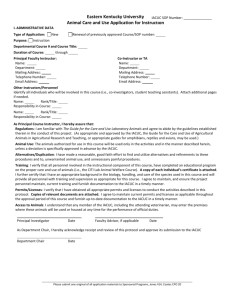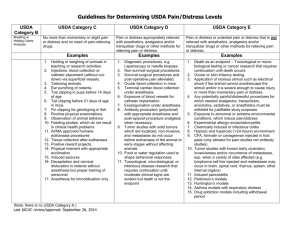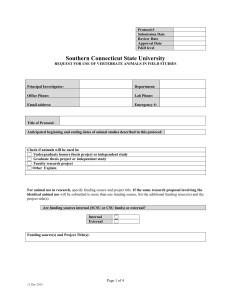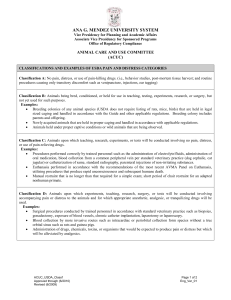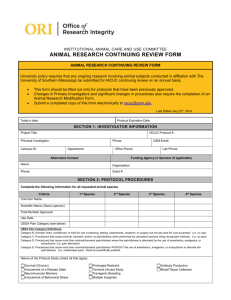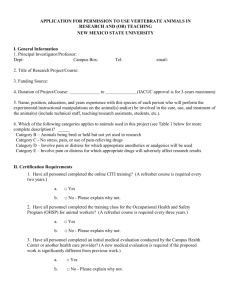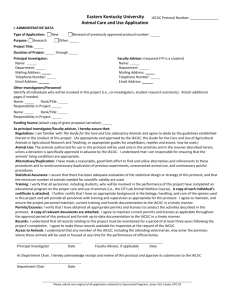Assigning Animals to USDA Pain & Distress Categories
advertisement
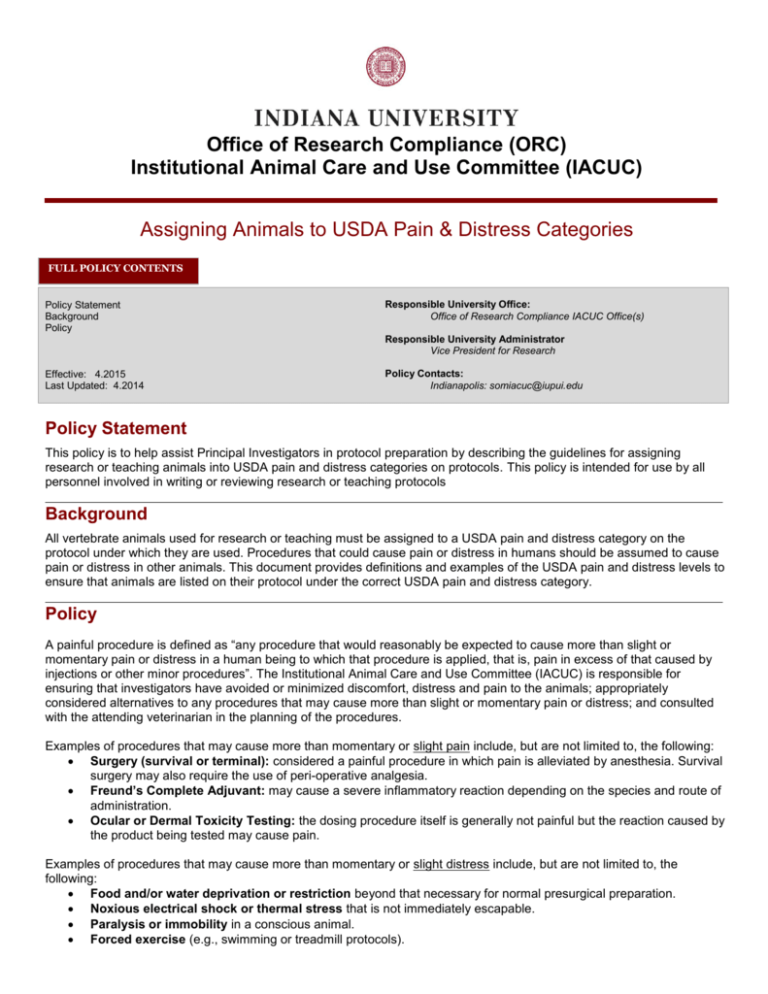
Office of Research Compliance (ORC) Institutional Animal Care and Use Committee (IACUC) Assigning Animals to USDA Pain & Distress Categories FULL POLICY CONTENTS Policy Statement Background Policy Responsible University Office: Office of Research Compliance IACUC Office(s) Responsible University Administrator Vice President for Research Effective: 4.2015 Last Updated: 4.2014 Policy Contacts: Indianapolis: somiacuc@iupui.edu Policy Statement This policy is to help assist Principal Investigators in protocol preparation by describing the guidelines for assigning research or teaching animals into USDA pain and distress categories on protocols. This policy is intended for use by all personnel involved in writing or reviewing research or teaching protocols Background All vertebrate animals used for research or teaching must be assigned to a USDA pain and distress category on the protocol under which they are used. Procedures that could cause pain or distress in humans should be assumed to cause pain or distress in other animals. This document provides definitions and examples of the USDA pain and distress levels to ensure that animals are listed on their protocol under the correct USDA pain and distress category. Policy A painful procedure is defined as “any procedure that would reasonably be expected to cause more than slight or momentary pain or distress in a human being to which that procedure is applied, that is, pain in excess of that caused by injections or other minor procedures”. The Institutional Animal Care and Use Committee (IACUC) is responsible for ensuring that investigators have avoided or minimized discomfort, distress and pain to the animals; appropriately considered alternatives to any procedures that may cause more than slight or momentary pain or distress; and consulted with the attending veterinarian in the planning of the procedures. Examples of procedures that may cause more than momentary or slight pain include, but are not limited to, the following: Surgery (survival or terminal): considered a painful procedure in which pain is alleviated by anesthesia. Survival surgery may also require the use of peri-operative analgesia. Freund’s Complete Adjuvant: may cause a severe inflammatory reaction depending on the species and route of administration. Ocular or Dermal Toxicity Testing: the dosing procedure itself is generally not painful but the reaction caused by the product being tested may cause pain. Examples of procedures that may cause more than momentary or slight distress include, but are not limited to, the following: Food and/or water deprivation or restriction beyond that necessary for normal presurgical preparation. Noxious electrical shock or thermal stress that is not immediately escapable. Paralysis or immobility in a conscious animal. Forced exercise (e.g., swimming or treadmill protocols). October 14, 2014 Infectious and inflammatory disease models. Some procedures, including any of those in the lists above, may cause both pain and distress. Examples of procedures that may cause more than momentary or slight pain as well as distress would include studies involving extensive irradiation, inhalation toxicity studies or those involving tumor growth. Animals exhibiting signs of pain, discomfort, or distress such as weight loss, decreased appetite, abnormal activity level, adverse reactions to touching inoculated areas, open sores/necrotic skin lesions, abscesses, lameness, conjunctivitis, corneal edema, and photophobia are expected to receive appropriate relief unless written scientific justification is provided in the animal activity proposal and approved by the IACUC. Definition and Examples of USDA Pain and Distress Categories USDA Category B Animals being held, bred, or conditioned for use in teaching, experiments, research or surgery, but not yet used for such purposes. USDA Category C Animals that are subject to procedures that cause no pain or distress, or only momentary or slight pain or distress and do not require the use of pain-relieving drugs. USDA Category D Animals subjected to potentially painful or stressful procedures for which they receive appropriate anesthetics, analgesics and/or tranquilizer drugs. Examples Holding protocol Animal breeding, pregnancy, parturition or lactation (note: if tail snips or other tissue is collected, Category B is not appropriate) Observation of animal behavior in the wild without manipulating the animal or it’s environment Euthanasia of animals on a holding protocol following AVMAacceptable methods (2013 guidelines) Examples Physical or chemical restraint and husbandry procedures, such as applying identification tags, ear notching/punching, tattoos, etc. Routine agricultural husbandry procedures approved by the IACUC in a protocol Holding or weighing animals in teaching, demonstration or research activities Observation of animal behavior in the lab Peripheral injections, blood collection or catheter implantation Gastric gavage Feed studies, which do not result in clinical health problems Live trapping Positive reward training or research Exposure to alteration in environmental conditions (not extreme) with appropriate conditioning and microenvironment Food restriction that reduces the animals weight by no more than 20% of normal age matched controls tail snips or other tissue is collected Examples Diagnostic procedures such as laparoscopy or needle biopsies Non-survival surgical procedures Survival surgical procedures Post-operative pain or distress w/ analgesics Retro-orbital blood collection Surgical catheter implantation Induced infections or antibody production Genetically engineered phenotype that causes pain or distress that will be alleviated Tumor induction or implantation if alleviation of pain/distress Terminal cardiac blood collection Anesthetize and release (i.e. for blood sampling) of wildlife Studies that involve special housing requests which are exceptions to the Guide such as: housing rodents on wire bottom cages; cages that do not conform to space and height recommendations; requests to house animals outside recommended temperatures Exsanguination with anesthesia Page 2 of 3 USDA Category E Animals subjected to potentially painful or stressful procedures that are not relieved with anesthetics, analgesics and/or tranquilizer drugs. Withholding anesthesia/analgesia must be scientifically justified in writing and approved by the IACUC. Examples Toxicological or microbiological or infectious disease research that requires continuation after clinical symptoms are evident without medical relief or require death as an endpoint. Ocular or skin irritancy testing Water deprivation beyond what is necessary for ordinary presurgical preparation where stress or physiologic impairment is a concern Food restriction which reduces the animals weight by more than 20% of normal age matched controls Application of noxious stimuli that the animal cannot avoid/escape Any procedure for which needed analgesics, tranquilizers, sedatives, or anesthetics must be withheld for justifiable study purposes Exposure to extreme environmental conditions Paralysis or immobilization of a conscious animal Genetically engineered phenotype that causes pain or distress that will not be alleviated Euthanasia by procedures not approved by the AVMA (2013) Use of adjuvants, which cause death of tissue resulting in tissue sloughing Induction of radiation sickness Long-term restraint (days to weeks) Forced exercise Infliction of burns or trauma Disease and cancer models that involve chronic clinical signs of disease and impairment of motor function October 14, 2014 Electrofishing Studies where death is an endpoint References USDA Policy #11: Painful and Distressful Procedures. Issue Date: March 25, 2011 References: AWA Section 2143, 9 CFR, Part 2, Sections 2.31(d)(1)(i,ii,iv), 2.31(e)(4), 2.33(b)(4), 2.36(b)(5,6,7) Guide for the Care and Use of Laboratory Animals 8th edition. 2011. Institute for Laboratory Animal Research. Washington DC: The National Academies Press. USDA Annual Report. http://oacu.od.nih.gov/ARAC/documents/USDA_Reports.pdf Cornell University IACUC Policy on Assessing Animals into USDA Pain and Distress Categories (http://www.iacuc.cornell.edu/documents/IACUC009.01.pdf Page 3 of 3
